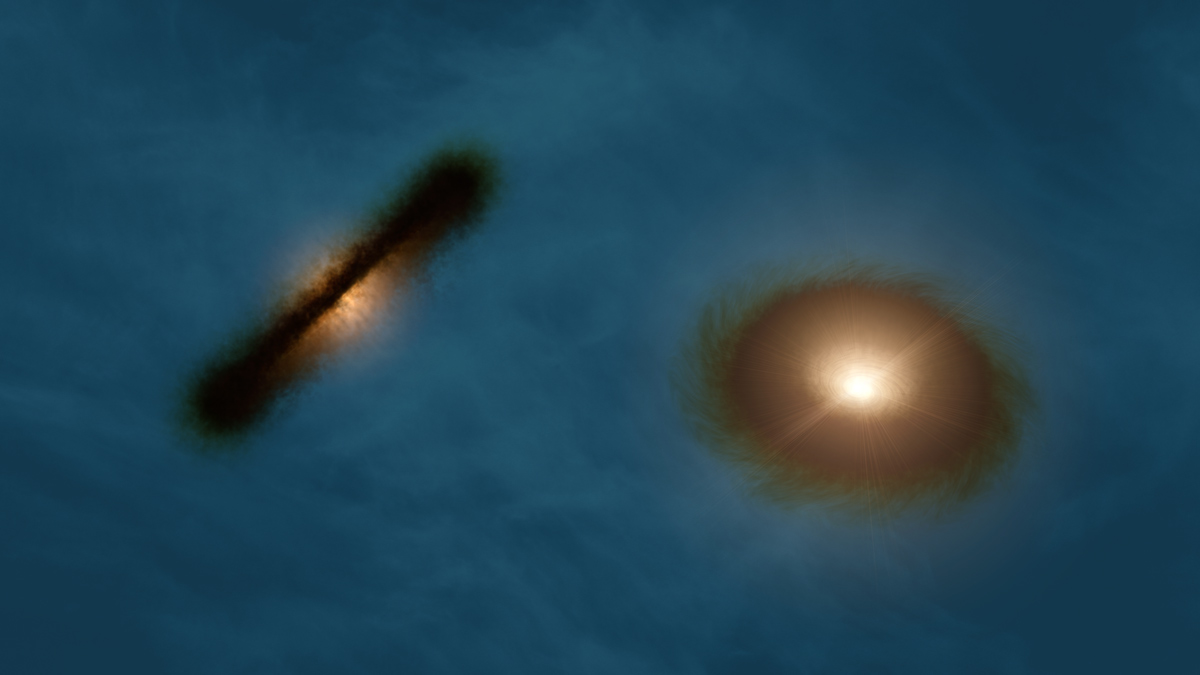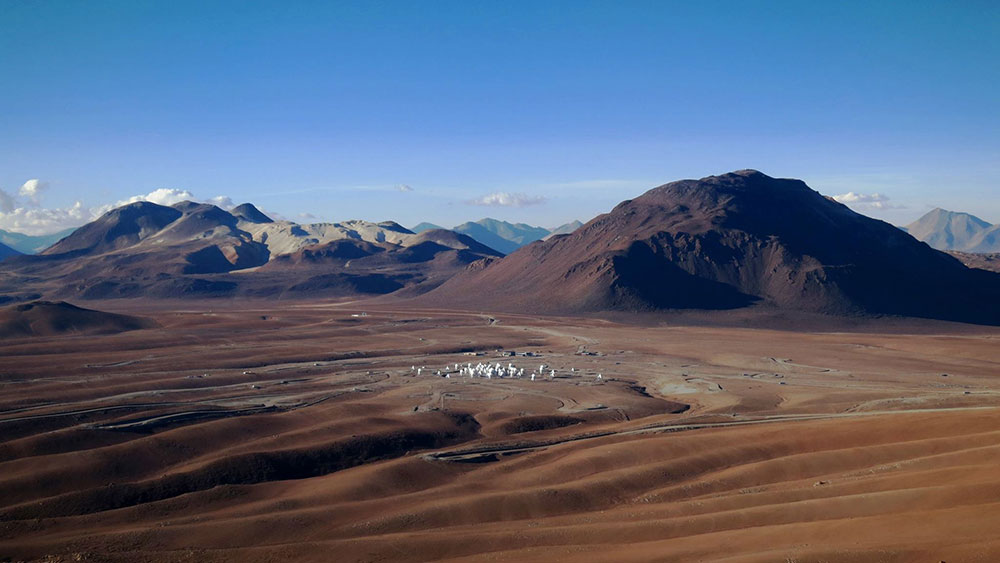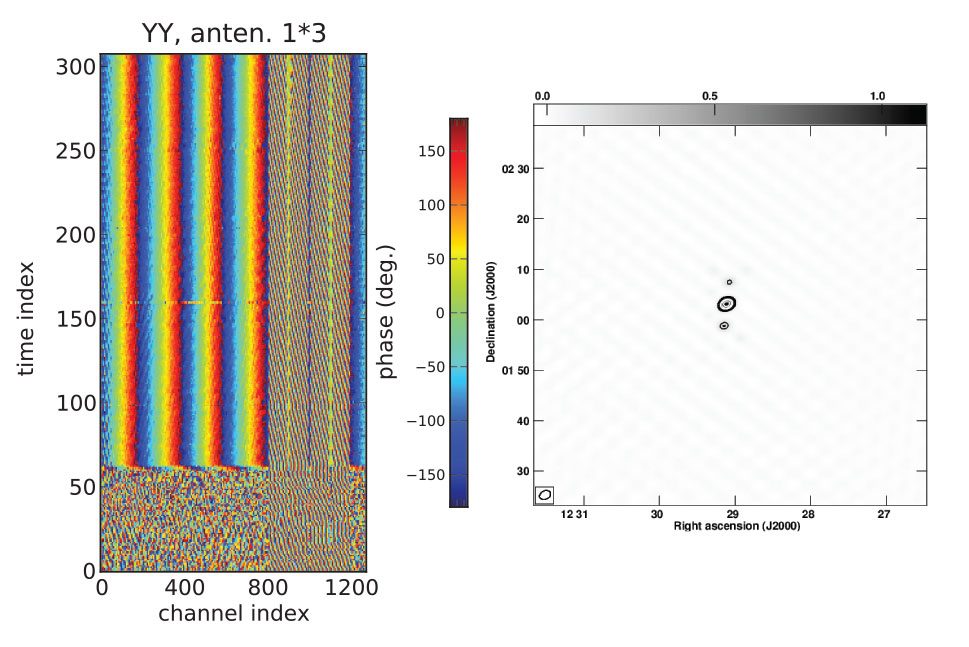NRAO eNews
Volume 7, Issue 9
20 August 2014
NRAO eNews
Volume 7, Issue 9 • 20 August 2014

Upcoming Events

MegaSAGE 2014 Surveying the Agents of Galaxy Evolution
Sep 02 - 05, 2014 | Charlottesville, VA

Filamentary Structure in Molecular Clouds
Oct 10 - 11, 2014 | Charlottesville, VA

4th VLA Data Reduction Workshop
Oct 27 - 31, 2014 | Soccoro, NM

Revolution in Astronomy with ALMA - The Third Year
Dec 08 - 11, 2014 | Tokyo, Japan
Misaligned Disks in a Young Binary System

R. Hurt (NASA/JPL-Caltech/IPAC)
[click to enlarge]
Many extrasolar planets follow orbits that differ from the nearly coplanar and circular orbits found in our Solar System. Extrasolar planet orbits may be eccentric or inclined with respect to the host star’s equator, and the population of giant planets orbiting close to their host stars suggests appreciable orbital migration. There is no consensus regarding what produces such orbits. Theoretical explanations often invoke interactions with a binary companion star in an orbit that is inclined relative to the planet’s orbital plane. Such mechanisms require significant mutual inclinations between the planetary and binary star orbital planes. The protoplanetary disks in a few young binaries are misaligned, but often the measurements of these misalignments are sensitive only to a small portion of the inner disk, and the three-dimensional misalignment of the bulk of the planet-forming disk mass has hitherto not been determined. Jensen and Akeson report that the protoplanetary disks in the young binary system HK Tauri are misaligned by 60 to 68 deg, such that one or both of the disks are significantly inclined to the binary orbital plane. Their results demonstrate that the necessary conditions exist for misalignment-driven mechanisms to modify planetary orbits, and that these conditions are present at the time of planet formation, apparently because of the binary formation process.
Reference
Misaligned Protoplanetary Disks in a Young Binary Star System, Eric L.N. Jensen (Swarthmore) and Rachel Akeson (IPAC/Caltech), 2014 Nature, 511, 567 (31 July 2014).
ALMA Progress

Neil Phillips.
[click to enlarge]
The ALMA antenna array has moved to configuration C34-6 – 3mm beam 0.6 arcsec, baselines 41-1090m – with the acceptance of key distant antenna stations; earlier observations in configuration C34-5, which includes baselines of 20-900m, were obtained. Observations requiring C34-7 will be made after the next austral summer. Beginning in September, several antennas will be moved to more distant stations to enable tests on baselines of 10km. Early Science will be suspended as key capabilities are readied for the ALMA Cycle 3 Call for Proposals, which will occur in austral autumn 2015.
Recent weather at Chajnantor has been very good, as is usual for the austral winter. From 1-7 August the precipitable water vapor remained below 1mm, and the resulting excellent high frequency transparency benefitted the high frequency campaign. Multiple objectives were met, including the imaging of Uranus with 29 array elements at ALMA Band 10 (350 microns, 810 GHz) by the Joint ALMA Observatory (JAO) Extension and Optimization of Capabilities (EOC) team. The EOC team also demonstrated the transfer of phase information from lower frequencies, where calibrators are brighter and more densely distributed, to higher frequencies and solved problems with total power observations. Simultaneous sub-arraying within the main 12m array was demonstrated for the first time, a key goal for achieving simultaneous EOC and Early Science operations. On Tuesday, 29 July, the ALMA Phasing Project team, with support from EOC, the ALMA Department of Engineering, and the ALMA Department of Computing integrated the new hydrogen maser into the ALMA system. This is an important milestone toward incorporating ALMA as a Very Long Baseline Interferometry array element. Tests have shown the maser performance is excellent, and it has replaced the rubidium clock as the ALMA time standard.
ALMA Cycle 2 Early Science began on 3 June, and eight one-week blocks have been completed. Current JAO operations allocate a week every two weeks to extending observational capabilities; three such one-week sessions were complete as of publication.
Nine ALMA Cycle 2 datasets has been delivered to North American (NA) PIs. During July, one new Cycle 2 Director’s Discretionary Time (DDT) project was received and reviewed. Carryover Cycle 1 projects continue to be observed with a priority below that of highest-ranked Cycle 2 projects; two-thirds of the highest-ranked NA Cycle 1 Projects have seen deliveries of some data. Data have been delivered for 2 DDT projects and ten partially observed filler projects. All Cycle 0 data have been delivered. A total of 109 of the 116 Cycle 0 projects are available in the ALMA Science Archive; only a few projects are still in their proprietary period. Ninety-one scientific papers based on these Cycle 0 projects have been published to date.
ALMA Conference Deadline Reminder: The registration deadline for poster contributions to the December 2014 Revolution in Astronomy with ALMA: the 3rd Year conference in Tokyo is 15 October 2014. Please visit the conference website for additional information and registration.
NAASC Evolution 2014 Workshop

The NRAO North American ALMA Science Center (NAASC) held its 8th annual science workshop – Transformational Science in the ALMA Era: Multi-wavelength Studies of Galaxy Evolution – from 4-7 August 2014. More than 110 scientists from 22 countries converged on Charlottesville, Virginia to explore multi-wavelength approaches to four central themes of galaxy evolution using current and future research facilities:
- the mass assembly history of galaxies, and the formation and evolution of galactic structure;
- the evolution of the interstellar medium and star formation over cosmic time;
- the role of large scale structure and environment; and
- the role of AGN in galaxy evolution.
A broad range of new and exciting science from ALMA and across the electromagnetic spectrum was discussed at this NAASC workshop. All the presentations from the NAASC Evolution 2014 Workshop will soon be available at the conference website.
4th VLA Data Reduction Workshop

There are still open spots for the fourth VLA Data Reduction Workshop, which will take place 27 - 31 October 2014 at the NRAO New Mexico Array Science Center (NMASC) in Socorro. At the rate registrations have been coming in, we expect to fill all 30 available places, so if you are interested we recommend you register soon.
The aim of this workshop is to assist observers with the data reduction challenges posed by the increased flexibility and complexity of the VLA. During the workshop, observers will be able to reduce their own VLA data using hardware provided by NRAO and with NRAO staff experts present for consultation. There will also be presentations by local staff covering CASA and the very latest developments in data reduction techniques.
This is an advanced workshop and, unlike our summer Synthesis Imaging Workshops, is not intended for those who are new to radio interferometry. Prior experience with AIPS, CASA, or MIRIAD is required. As we will be using CASA as our main data reduction package, a working knowledge of it would be helpful: we strongly recommend those new to CASA to go through one or more of our tutorials prior to attending the workshop.
For further details, and to register, please visit the Workshop website.
We look forward to welcoming you to Socorro!
VLITE First Fringes

[click to enlarge]
The Naval Research Laboratory (NRL) and NRAO have successfully teamed to obtain first fringes on the Very Large Array (VLA) Low Frequency and Ionosphere Transient Experiment (VLITE). VLITE is a 10-antenna commensal system continuously accessing 64 MHz from the new 236-492 MHz Low Band system. Its backend includes dedicated samplers, fiber optics, and a DiFX-based software correlator. By harvesting data from the VLA’s prime focus, VLITE can provide 5000+ hours of “free” observing time a year, effectively making the VLA “two telescopes in one”. VLITE is a multi-year project commencing this fall, and could pave the road towards a full VLA Low Band Observatory, or LOBO system, in the future.
VLITE became sentient at ~20h 30m UT on 17 July 2014, soon after the first antennas came on line in early July. The left side of the Figure shows the phase of the cross-correlation function as a function of time (vertical) and frequency (horizontal) between VLITE antennas 1 and 3, corresponding to VLA antennas 14 and 23, after the quasar 3C273 enters the field-of-view. The length of the scan is about 10 minutes, and the ~6.5 fringes seen across the 64 MHz bandwidth (λ~1 meter) correspond to a residual delay error of ~100 nsec. Since then, more antennas have been added and simple images of calibrators – including 3C273 (see Figure, right side), made from 5 antennas – are starting to emerge.
VLITE has two main scientific drivers, and one ethereal one. The first is to provide continuous, near real-time monitoring of ionospheric waves over the VLA. VLITE is significantly more sensitive to tiny fluctuations in ionospheric total electron content than GPS, opening a new field of ionospheric remote sensing. The second scientific goal is a continuous, blind search for astronomical transients, both fast (pulsars and fast radio bursts) and slow (supernovae, gamma-ray bursts, etc.). VLITE plays to the strength of transient observations by accessing a wide field-of-view (~5 square degrees) nearly continuously. Finally, VLITE challenges the paradigm of targeted observations catering to a priori science. Its exploration-driven model seeks to reinforce the value of serendipity in a landscape increasingly dominated by perceived “transformational” science goals.
VLITE is an NRL-funded project supported by NRAO; Namir Kassim is the PI.
NRAO Hosts Broadband Summit

Mike Holstine, NRAO, and Judge Dan O’Hanlon, Chairman of the WV Broadband Deployment Council and head of a fiber network provider.
[click to enlarge]
The NRAO hosted a broadband summit on Wednesday, 23 July 2014 at its Green Bank, West Virginia (WV) site to open up communications concerning the limited state of Internet access for residents of Pocahontas County, where the Observatory is located. Part of the reason for the NRAO involvement is the limitations that the National Radio Quiet Zone places on the communications technologies that can be implemented near the NRAO - Green Bank site. The Summit was conceived and coordinated by Michael Holstine, Business Manager for NRAO –WV Operations. The summit brought representatives from all aspects of the regulatory, governmental, and industrial arena and was open to the public. Invitees attending included Federal and State representatives, regional and multi-county economic development offices, and all existing broadband providers serving eastern WV.
The WV Broadband Deployment Council, a body of legal, industrial, educational and governmental representatives, held their July meeting at the site prior to the summit – their first meeting held outside the state capital of Charleston in their six-year history. Judge Dan O’Hanlon governs the Council and the body approved a motion to spend their remaining Fiscal Year funds on a project within Pocahontas and Randolph counties to complete an open access fiber ring for residential Internet services.
The presentations ranged from existing conditions for Internet access to the construction of fiber-to-the-home networks in other areas. With an excellent attendance and a huge interest from all involved in bettering the existing conditions in the county, the summit was a step forward in pushing technology infrastructure for NRAO employees at home and all area residents. Further information about the summit can be found at the Pocahontas Times website.
Recent Media Releases
Career Opportunities
New Postings
Scientist: The NRAO in Green Bank, West Virginia is now accepting applications for a Scientist position. Responsibilities of the successful applicant(s) will include supporting observers who use the telescope as well as working on a diverse variety of projects, which may include the development and commissioning of new instrumentation on the telescope, working with the engineering staff to improve the overall telescope performance, and aiding with the data reduction pipelines needed for the GBT.
Software Build and Test Engineer: The NRAO is now accepting applications for a Software Build and Test Engineer. This position may be located in Socorro, NM or Charlottesville, VA. The Software Engineer will be a member of the Common Astronomy Software Applications (CASA) development team. The new team member will primarily be responsible for CASA builds, build support and release packaging. As part of these duties, the Software Engineer will participate in extending the current build system (currently based on Cmake) and the existing automated test system (currently based on Jenkins and Robot Framework).
Electronics Engineer II: The NRAO in Green Bank, West Virginia is now accepting applications for an Electronics Engineer position. Using prescribed methods, researches, conducts or coordinates detailed phases of digital system engineering work as assigned. The candidate will perform work that involves conventional engineering practices and will also be a part of Green Bank’s Electronics Division, which oversees all electronics engineering related activities for Robert C. Byrd Green Bank Telescope (GBT).
Software Engineer II (401): The NRAO in Green Bank, West Virginia is now accepting applications for a Software Engineer II position. Using prescribed methods, researches, conducts or coordinates detailed phases of software engineering work as assigned. The candidate will perform work that involves conventional software engineering practices.
Software Engineer II (441): The NRAO is now accepting applications for a Software Engineer II position. Collaboratively with other NRAO staff, evaluate, deploy, maintain, and write web applications for the North American ALMA Science Center (NAASC) user portal, and support the configuration and operation of the NRAO Science helpdesk. This will require leveraging of existing NRAO web services and content, development of ALMA (Atacama Large Millimeter Array) and NRAO web service prototypes, and new technologies.
Software Engineer II (262): The NRAO in Charlottesville, VA is now accepting applications for a Software Engineer II position. The successful applicant will work with CASA (Common Astronomy Software Applications) developers, project scientists, and stakeholders to design and implement a comprehensive test program. Duties will include assuming responsibility for existing test systems, improvement of existing test, and evaluation of test coverage for new capabilities.
Mechanical Engineer II: The NRAO in Socorro, NM is now accepting applications for a Mechanical Engineer II position. The candidate will be responsible for the carrying out and assisting in engineering analysis, design, and general execution of a project or whole system. Responsibilities include recommendations, coordination and assisting in decisions on such aspects as design, procurement, manufacture, erection, test and some degree of initial operation.
From the Archives
Ellen Bouton

[click to enlarge]
About this month's photograph: Charlie the rubidium clock, carried by Barry Clark from the US to Crimea – via New York, Amsterdam, Bonn, Copenhagen, and Moscow – for use in the May 1971 US-USSR VLBI experiment. Prepared for travel in his special case, Charlie weighed 70 kilos. His trip included air freight, brief but worrisome disappearances from the air freight system, suspicious customs agents, bonding agents, reams of paperwork, calls to embassies, automobile trunks too small to carry him, breaker-tripping encounters with 220 volt lines, and several near death experiences as his charge almost ran out. The full story of Charlie's trip, and Barry Clark's as well, may be found in Barry's two “Travels with Charlie" articles in The Observer, the first in the January 1972 issue and the second in the April 1972 issue.
From the Archives is an ongoing series illustrating NRAO and U.S. radio astronomy history via images selected from our collections of individuals' and institutional papers. If readers have images they believe would be of interest to the Archives, please contact Ellen Bouton, ebouton@nrao.edu.

